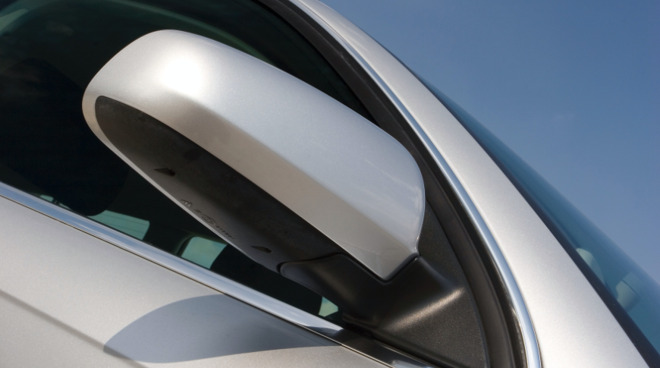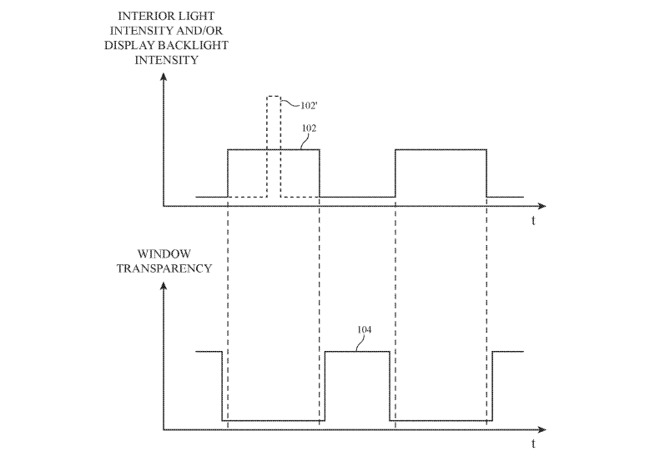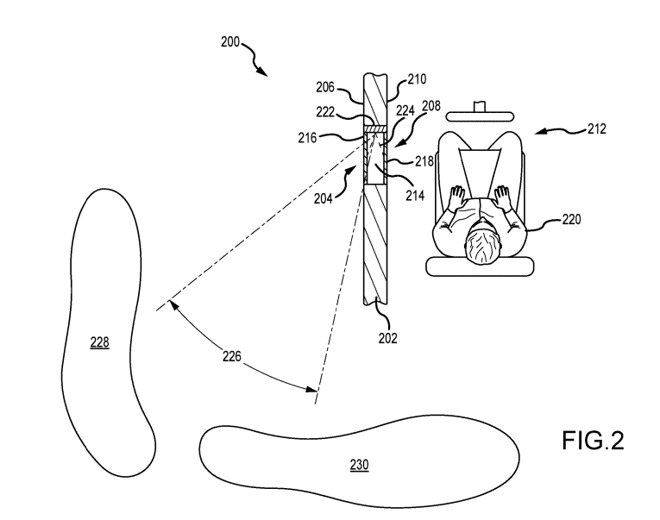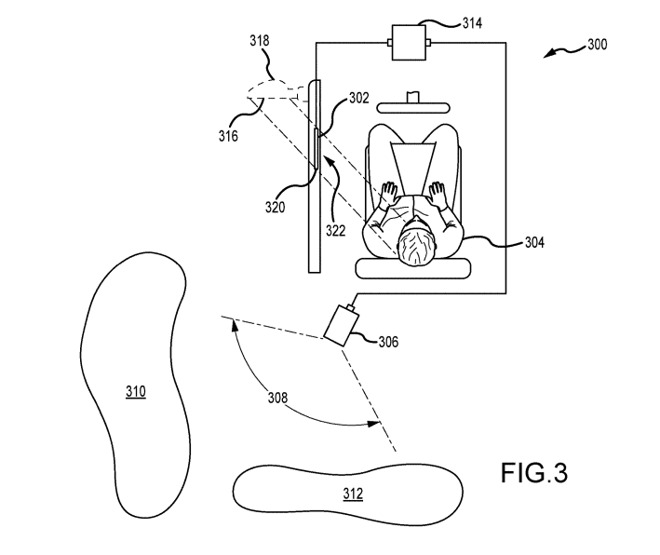Apple working on privacy-based lighting system, unique headlights for car
A future car designed by Apple could offer increased privacy via the use of 'synchronized windows,' as well as side mirrors capable of automatically adjusting their positions based on the driver's head movements.

Apple was granted a collection of patents on Tuesday by the US Patent and Trademark Office relating to car design. The company is widely believed to be working on some form of vehicular product or service under the codename "Project Titan," possibly an Apple Car, with the latest patents adding to a large number of other design ideas Apple has come up with over time.
In the patent, Apple suggests the windows can have a light modulator layer, such as one made of liquid crystal with polarizers, a cholesteric liquid crystal layer for alterable reflectivity, an adjustable haze layer from a polymer-dispersed liquid crystal layer, or something similar. Regardless of the material, it is the creation of a controllable layer that can adjust how light passes through a window.
It is suggested there could be sources of light from both inside and outside the vehicle, which can be modulated with "alternating current modulation waveforms," in such a way that it doesn't affect a passenger's vision. For example, a light inside the vehicle could be turned on and off multiple times a second in a specifically controlled manner, such as at 200Hz, but so quickly that the user cannot perceive the changes in state.

A time-based graph showing when the light is bright, the window layer is set to obscure light, and vice versa
While it cannot be seen by the user, the turning on and off can be made to coincide with the activation and deactivation of the layer in the windows. Just as with the light's state, changing the state of the window fast enough will make it seem transparent to the user in a similar way.
By timing the light to be on and off at the same time as the window layer is activated or turned off, this can lead to a situation where the light illuminates the inside of the vehicle, but the window layer blocks the light from leaving through the window. In the other state, the window allows light to pass through, but the internal light is off.
In effect, this means passengers will see the interior light and things illuminated by it, while people outside the vehicle would not.
Apple has previously examined the possibility of using light to provide privacy, but by using band-based light instead of using time. In May, a patent describes how light of a specific band could be used to illuminate the vehicle, but a window treatment could selectively block out the light within specific bands while allowing others through, giving a similar effect.
The inventors of this patent are Martin Melcher, James Wilson, Clarisse Mazuir, and David Kingman.
Melcher is a senior product design engineer for Apple, who worked on the ECG electrode on the Apple Watch Series 4 and Series 5. Patents in Melcher's name largely consist of light-based applications, including the aforementioned interior lighting patent, transparent panes with heatable coatings, windows with invisible patterned conductive layers, and light-scattering films.
Wilson is also a senior product design engineer, with expertise in materials. Related patents in his history include devices with infrared transparent one-way mirrors, textured light-scattering films, surface glass with embedded ceramic particles, and high-luminance surfaces.
Mazuir is a technology development leader for lighting and sensors at Apple SPG. Her name is linked to patents for systems with textured light-scattering films, adjustable lighting systems, lights in vehicle seating, and others in the field.
Product design engineer Kingman has been connected with quite a few car-related patents, such as the adjustable lighting system, extendable bumpers, and the earlier banded light patent.
In the first example, the mirror is attached to an actuator, relatively similar to how some versions available today function to tuck in the mirror and to extend them at the start and end of a journey. Rather than doing so at the beginning or the end and leaving it static throughout, Apple proposes it could change its position through the journey.
Using a camera sensor pointed at the driver's face, the system can monitor the driver's head movements by looking at a facial feature's orientation. If it is determined the driver is looking in the mirror's direction by the camera, a signal is sent to the mirror for it to actuate out into position, and to retract when it is not required.

A version of the side mirror embedded in the car bodywork.
A second implementation is an integrated side mirror, which is fitted into the wall of the car itself and takes advantage of optical elements on each side to provide the driver with a view of the outside. It is suggested the view offered would be enough to see nearby elements similarly to a normal externally-mounted side mirror.
The third variation on the theme is to remove the side mirror entirely, and replace it with a monitor. Attached to the inside of the vehicle in the place where the driver would look for the side mirror, a display would provide a live video feed from a camera mounted on the rear of the vehicle, giving a view of the area typically covered by the mirror's reflection.
Rather than giving a direct live feed, the system would perform processing on the image to create a similar image to what the driver would expect to see from the mirror, as the camera's position and field of view would differ.

A version of the side mirror using a display and camera
Such a system would still provide a benefit of potentially giving a wider field of view than the reflection ever could, as well as for areas behind the vehicle that are typically blocked to the driver.
The patent lists the inventors as David G Havskjold, Arthur Y. Zhang, Hyungryul Choi, Matthew E. Last, and Clarisse Mazuir once more.
A product design engineer, Havskjold is a co-inventor for patents for a wide variety of areas, ranging from cover glass arrangements for electronic devices, hidden signal paths for lighting systems, retail fixtures, and a low-profile connector.
Zhang is a display expert for Apple, linked to patents involving screens of varying kinds, such as storing the long-term history of pixel luminance values to compensate for the effects of burn-in, ambient light color compensation, and lighting in augmented reality environments.
Choi is an engineering manager who works on display and optical technologies for Apple, and his patents list is largely in the same field, including displays with switchable film structures, a heads-up display for vehicles, and an active glare suppression system for cars.
Formerly an Apple engineering manager linked to the Special Projects Group but currently employed at Waymo, Last is, as expected, connected with a lot of car patents. These range from the lighting systems for vehicle seats to "systems with matte infrared-transparent layers," autonomous navigation systems, securable storage compartments, and heads-up displays.
Apple files numerous patent applications every week, but while the existence of a filing indicates areas of interest for the company's research and development efforts, there is no guarantee the concepts described will make an appearance in a future product or service.

Apple was granted a collection of patents on Tuesday by the US Patent and Trademark Office relating to car design. The company is widely believed to be working on some form of vehicular product or service under the codename "Project Titan," possibly an Apple Car, with the latest patents adding to a large number of other design ideas Apple has come up with over time.
Private Lighting
The first patent for "Systems with synchronized windows" effectively describes how a vehicle could include an element of privacy, by having control over the vehicle's windows.In the patent, Apple suggests the windows can have a light modulator layer, such as one made of liquid crystal with polarizers, a cholesteric liquid crystal layer for alterable reflectivity, an adjustable haze layer from a polymer-dispersed liquid crystal layer, or something similar. Regardless of the material, it is the creation of a controllable layer that can adjust how light passes through a window.
It is suggested there could be sources of light from both inside and outside the vehicle, which can be modulated with "alternating current modulation waveforms," in such a way that it doesn't affect a passenger's vision. For example, a light inside the vehicle could be turned on and off multiple times a second in a specifically controlled manner, such as at 200Hz, but so quickly that the user cannot perceive the changes in state.

A time-based graph showing when the light is bright, the window layer is set to obscure light, and vice versa
While it cannot be seen by the user, the turning on and off can be made to coincide with the activation and deactivation of the layer in the windows. Just as with the light's state, changing the state of the window fast enough will make it seem transparent to the user in a similar way.
By timing the light to be on and off at the same time as the window layer is activated or turned off, this can lead to a situation where the light illuminates the inside of the vehicle, but the window layer blocks the light from leaving through the window. In the other state, the window allows light to pass through, but the internal light is off.
In effect, this means passengers will see the interior light and things illuminated by it, while people outside the vehicle would not.
Apple has previously examined the possibility of using light to provide privacy, but by using band-based light instead of using time. In May, a patent describes how light of a specific band could be used to illuminate the vehicle, but a window treatment could selectively block out the light within specific bands while allowing others through, giving a similar effect.
The inventors of this patent are Martin Melcher, James Wilson, Clarisse Mazuir, and David Kingman.
Melcher is a senior product design engineer for Apple, who worked on the ECG electrode on the Apple Watch Series 4 and Series 5. Patents in Melcher's name largely consist of light-based applications, including the aforementioned interior lighting patent, transparent panes with heatable coatings, windows with invisible patterned conductive layers, and light-scattering films.
Wilson is also a senior product design engineer, with expertise in materials. Related patents in his history include devices with infrared transparent one-way mirrors, textured light-scattering films, surface glass with embedded ceramic particles, and high-luminance surfaces.
Mazuir is a technology development leader for lighting and sensors at Apple SPG. Her name is linked to patents for systems with textured light-scattering films, adjustable lighting systems, lights in vehicle seating, and others in the field.
Product design engineer Kingman has been connected with quite a few car-related patents, such as the adjustable lighting system, extendable bumpers, and the earlier banded light patent.
Side Mirrors
The second patent titled "Systems for improving side-mirror functionality of a vehicle" offers several ways to improve the design of the side mirror. Chiefly the patent details how to minimize the width of the vehicle, either by having the side mirrors extend outwards when required, or replacing them completely.In the first example, the mirror is attached to an actuator, relatively similar to how some versions available today function to tuck in the mirror and to extend them at the start and end of a journey. Rather than doing so at the beginning or the end and leaving it static throughout, Apple proposes it could change its position through the journey.
Using a camera sensor pointed at the driver's face, the system can monitor the driver's head movements by looking at a facial feature's orientation. If it is determined the driver is looking in the mirror's direction by the camera, a signal is sent to the mirror for it to actuate out into position, and to retract when it is not required.

A version of the side mirror embedded in the car bodywork.
A second implementation is an integrated side mirror, which is fitted into the wall of the car itself and takes advantage of optical elements on each side to provide the driver with a view of the outside. It is suggested the view offered would be enough to see nearby elements similarly to a normal externally-mounted side mirror.
The third variation on the theme is to remove the side mirror entirely, and replace it with a monitor. Attached to the inside of the vehicle in the place where the driver would look for the side mirror, a display would provide a live video feed from a camera mounted on the rear of the vehicle, giving a view of the area typically covered by the mirror's reflection.
Rather than giving a direct live feed, the system would perform processing on the image to create a similar image to what the driver would expect to see from the mirror, as the camera's position and field of view would differ.

A version of the side mirror using a display and camera
Such a system would still provide a benefit of potentially giving a wider field of view than the reflection ever could, as well as for areas behind the vehicle that are typically blocked to the driver.
The patent lists the inventors as David G Havskjold, Arthur Y. Zhang, Hyungryul Choi, Matthew E. Last, and Clarisse Mazuir once more.
A product design engineer, Havskjold is a co-inventor for patents for a wide variety of areas, ranging from cover glass arrangements for electronic devices, hidden signal paths for lighting systems, retail fixtures, and a low-profile connector.
Zhang is a display expert for Apple, linked to patents involving screens of varying kinds, such as storing the long-term history of pixel luminance values to compensate for the effects of burn-in, ambient light color compensation, and lighting in augmented reality environments.
Choi is an engineering manager who works on display and optical technologies for Apple, and his patents list is largely in the same field, including displays with switchable film structures, a heads-up display for vehicles, and an active glare suppression system for cars.
Formerly an Apple engineering manager linked to the Special Projects Group but currently employed at Waymo, Last is, as expected, connected with a lot of car patents. These range from the lighting systems for vehicle seats to "systems with matte infrared-transparent layers," autonomous navigation systems, securable storage compartments, and heads-up displays.
Apple files numerous patent applications every week, but while the existence of a filing indicates areas of interest for the company's research and development efforts, there is no guarantee the concepts described will make an appearance in a future product or service.

Comments
That way by the time it is ready to reveal you might be able to beat your competition. (probably not).
A related tangent: This is what the combination of properly angled rear and side-view mirrors do for you now. If you're on the freeway and a car is coming up from behind to pass you, you should be able to continuously view that car, first in the rear-view mirror at center and then going off to the left (or right), and as it comes to the edge of the rear-view mirror, it comes into view on the inside of the side-view mirror, and as it starts going off the outside of the side mirror, it's beside you in your direct field of view. There should be no blind spots. This requires you to angle your side-view mirrors further outward than most people like to do.
This is a pet-peeve for me... if you have set your side-view mirrors so that you can see the side of your own car (ostensibly to use that as a visual reference point), you're doing it wrong. You've set it so that a person in the next lane - right by your rear quarter panel - will be in a blind spot outside the mirror's view, and when you try to change lanes and think you are all clear, you will hit that other person. Think I'm wrong? Next time you're on the highway, carefully ease up to pass someone, and when you're right at their back wheel, look in their side-view mirror. If you see the side of their car instead of their eyes, they can't see you either. They've angled their mirrors too far in, so that they can have that visual reference point of the side of their own car. They can see their own car and a few inches out from it, but they can't see you right there in the next lane. The thing is, you don't need that side-of-your-own-car visual cue once you get used to the correct mirror positions. Being able to see what's an inch from the side of your car is of no value, because by the point you see someone in that space, it's too late. You needed to see them before that, when they were a couple feet to your side, before you changed lanes and plowed into them.
The backup camera is occasionally distorted by splashes of water or mud. I've had snow on the front bumper partly obscure that part of the birds-eye view.
The rear view mirror has a built in high resolution display connected to a wide angle camera in the tailgate. It works well under certain circumstances. You get an unobstructed 3 lane wide view to the rear, but it gets a bit washed out/overwhelmed by headlights at night. The worst part is that every time you glance at it you have to refocus on a screen that's only about 18" from your eyes.
I find that techies and doctors have at least one thing in common — they believe that since they’re an expert in one thing, they must also be experts in other, unrelated things. Errrnnnt.
As the tail of the car moves off the sideview, it appears on the rearview. It's absolutely seamless, without blind spots.
Which is how we were taught to adjust them for years and years. Sighting along the sides of the car was to aid in backing up. Yet we were also taught to put our arm on the seat back (most cars had bench seats then) and turn and look out the back window.
When in traffic I still do a 'shoulder check' 'cuz that's what I was taught. But it's was a revelation to learn how to eliminate blind spots (some narrow car windows don't help).
Before I learned to adjust the mirror properly, I had one of those WINK mirror devices that strung several mirrors along the top of the windshield effectively reducing the view of traffic lights and giving an odd movement of traffic, almost like looking in a fun hose of mirrors.
Properly adjusted, the three factory mirrors provide a much more natural view.
There is nothing in my quote that implies a dislike of Apple. I criticized the concept. A moving mirror in a moving vehicle is dumb and unsafe. So a little less "defend the precious" and a little more critical thinking might be on order. I seriously doubt you, the defender, could find a way to make it justifiable. Just a thought.
Still waiting for you or anyone else to offer something of substance that counters my claim of silliness. So far all I got is ad hominem "you're no expert" and "smart people" worked on it. While both of those things are true, neither counters my claim. I literally don't think there is a scenario anyone can come up with where eye tracking movable mirrors makes sense in a moving vehicle.